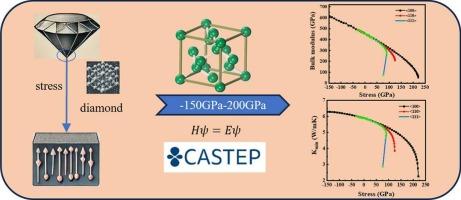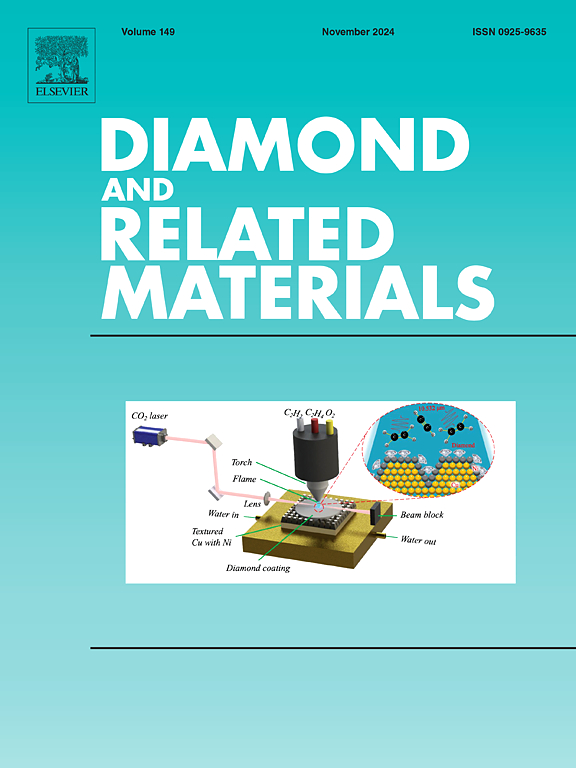金刚石在外力作用下的机械性能和热性能变化
IF 4.3
3区 材料科学
Q2 MATERIALS SCIENCE, COATINGS & FILMS
引用次数: 0
摘要
金刚石具有超强的硬度和导热性,因此被广泛应用于工业切割、电子设备和激光技术等领域,这些应用通常要求金刚石在极端条件下保持优异的性能。极限强度、硬度和断裂韧性是决定其耐用性的关键参数。研究金刚石在应力作用下的机械性能演变,可以更深入地了解其在极端环境下的变形机制和失效模式,有助于优化金刚石在高应力应用中的性能。在热性能方面,金刚石的高热导率使其在电子和光子设备的散热方面具有很高的价值。应力会改变金刚石内部晶格振动所诱发的声子机制,从而导致其热导率发生变化。了解这些变化可以进一步提高金刚石在大功率设备中的散热能力。本文基于第一性原理,系统地研究了金刚石在单轴应力和静水压力下的综合力学性能和热性能。包括杨氏模量、体模量、剪切模量和泊松比在内的弹性常数随压应力的增大而增大,随拉应力的增大而减小。在外力作用下,由于不同方向的变形,体积模量的各向同性被打破。弹性常数表明,金刚石的机械性能随压应力的增加而增加,随拉应力的增加而减少。德拜温度、声速(纵向、横向和平均速度)和最小热导率等热特性也随压应力的增加而增加,随拉应力的增加而减少。出现上述现象的根本原因是外加应力改变了金刚石的晶格结构。随着 C 原子周围电荷的重新分布,金刚石的结构对称性被打破,从而导致新的平衡状态。导致热导率变化的声子也会随应力变化。这些理论结果为我们了解应力对金刚石机械和热性能的影响提供了宝贵的见解。我们还为在高应力环境下在金刚石中使用拉曼激光提供了基本的理论实践指导。本文章由计算机程序翻译,如有差异,请以英文原文为准。

Evolution of mechanical and thermal properties of diamond under external stress
Diamond exhibits ultra hardness and thermal conductivity, which makes it widely utilized in industrial cutting, electronic devices, and laser technology, where these applications typically require diamond to maintain excellent performance under extreme conditions. Ultimate strength, hardness, and fracture toughness are key parameters that determine its durability. Investigating the evolution of mechanical properties under stress provides deeper insights into its deformation mechanisms and failure modes in extreme environments, facilitating the optimization of diamond for high-stress applications. For thermal properties, the high thermal conductivity makes it highly valuable for heat dissipation in electronic and photonic devices. Stress can change the mechanisms of phonon induced by lattice vibration within the diamond, leading to changes in its thermal conductivity. Understanding these variations can further enhance its heat dissipation capabilities in high-power devices. In this paper, the comprehensive mechanical and thermal properties of diamond under uniaxial stress and hydrostatic pressure are investigated systematically based on the first-principles. The elastic constants including Young's modulus, bulk modulus, shear modulus and Poisson's ratio enhance with the compressive stress and diminish with the tensile stress. The isotropy of bulk modulus is broken due to the deformation of different directions under external stress. Based on the elastic constants, it demonstrates that the mechanical properties of diamond enhance with the compressive stress and diminish with the tensile stress. The thermal properties including Debye temperature, sound velocity (longitudinal, transverse and average velocity) and minimum thermal conductivity also enhance with the compressive stress and diminish with the tensile stress. The fundamental reason for the above phenomenon is that applied stress changes the lattice structure of diamond. And the structural symmetry of diamond is broken along with the redistribution of charge around C atoms, that leads to a new equilibrium state. The phonons that contribute to the thermal conductivity also change with stress. These theoretical results provide valuable insights into the influence of stress on the mechanical and thermal properties of diamond. We also provide basic theoretical practical guidance for the use of Raman laser in diamond under high stress environment.
求助全文
通过发布文献求助,成功后即可免费获取论文全文。
去求助
来源期刊

Diamond and Related Materials
工程技术-材料科学:综合
CiteScore
6.00
自引率
14.60%
发文量
702
审稿时长
2.1 months
期刊介绍:
DRM is a leading international journal that publishes new fundamental and applied research on all forms of diamond, the integration of diamond with other advanced materials and development of technologies exploiting diamond. The synthesis, characterization and processing of single crystal diamond, polycrystalline films, nanodiamond powders and heterostructures with other advanced materials are encouraged topics for technical and review articles. In addition to diamond, the journal publishes manuscripts on the synthesis, characterization and application of other related materials including diamond-like carbons, carbon nanotubes, graphene, and boron and carbon nitrides. Articles are sought on the chemical functionalization of diamond and related materials as well as their use in electrochemistry, energy storage and conversion, chemical and biological sensing, imaging, thermal management, photonic and quantum applications, electron emission and electronic devices.
The International Conference on Diamond and Carbon Materials has evolved into the largest and most well attended forum in the field of diamond, providing a forum to showcase the latest results in the science and technology of diamond and other carbon materials such as carbon nanotubes, graphene, and diamond-like carbon. Run annually in association with Diamond and Related Materials the conference provides junior and established researchers the opportunity to exchange the latest results ranging from fundamental physical and chemical concepts to applied research focusing on the next generation carbon-based devices.
 求助内容:
求助内容: 应助结果提醒方式:
应助结果提醒方式:


